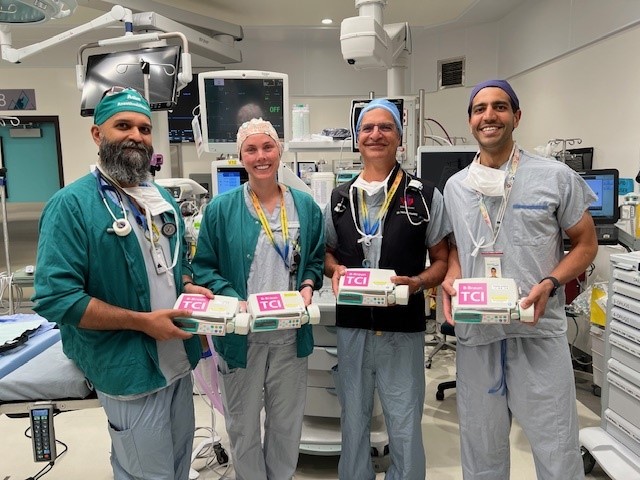When anesthesiologist Dr. Shamir Karmali learned about the many benefits of using total intravenous anesthesia (TIVA) to deliver general anesthesia without the use of inhalational anesthetics, he was sold on the idea. He also learned that target-controlled infusions (TCI) are the gold standard means of delivery of TIVA and overcome many barriers to its use.
“TIVA has many patient, health-economic, and environmental benefits, but providers under-utilise it due to perceived increased effort, difficulty and unfamiliarity with how to ensure adequate depth of anesthesia, titrate infusions and facilitate timely reversal of anaesthesia for OR efficiency,” said Dr. Karmali. “The goal of our Small Steps, Big Idea project was to educate and mentor a critical mass of our department members on using TIVA and TCI who would then go on to educate more members in a cascading manner.”
Today, there are 14 TCI pumps at VGH and UBC Hospital, up from two at the start of Dr. Karmali’s project. These are used every day, and he reports that there is more interest than pumps available.
Dr. Karmali did not anticipate the level of interest in his project from other sites. The BC Anesthesiology Society (BCAS) has asked to use the education module that was created and to promote it provincially to increase TIVA use. There is discussion around physicians who take the module earning CME credits. Other health authorities are using the module and there are plans for it to be advertised provincially.
“We’ve developed a strong relationship with BCAS as well as with other sites and health authorities that are interested,” said Dr. Karmali. “I often receive communications and positive feedback from colleagues and residents for creating this resource and pushing the project forward.”
Dr. Karmali credits residents and the power of word of mouth for sparking the widespread interest in the project.
“I hadn’t considered dissemination of this idea by residents, but in hindsight, this seems like a great mechanism to cross-pollinate ideas across different institutions,” he said. “I will use the relationships I developed with them as well as other groups to elicit interest and opportunities for collaboration on future projects.”
Dr. Karmali notes that the success of his idea was contingent upon departmental support, capital costs for the pumps and consumables as well as support from the anesthesia assistants. Without this support, the project could not have proceeded.
He added, “Continuous feedback from colleagues has helped shape this rollout and the learning material. Without a continuous cycle of change-feedback-revision, I do not think the digestibility of the information and reception would have been as successful. I am grateful for the open-mindedness and early-adoption philosophy of our department, which is where the credit is due.”
Benefits of using TCI and TIVA
Patient benefits:
- Intra-operative physiological benefits in specific surgical groups: neurosurgery, thoracic surgery, ENT, shared-airway surgery.
- Reduced post-op complications (PONV, adverse airway events, emergence delirium).
- Improved patient-reported outcome and experience measures.
Environmental benefits:
- Reduced carbon footprint (20-fold lower carbon footprint then inhalational anaesthesia, Bernat et al 2024).
- Reduced staff occupational exposure to inhalational agents and reduced greenhouse gas pollution and ozone depletion (Sherman et al 2012).
Health-economic benefits:
- Reduced PACU stay.
- Faster discharge following ambulatory surgery.
Photo (from left): Drs. Asim Iqbal, Courtney Lloyd, Hamed Umedaly, and Shamir Karmali hold four of the TCI pumps available to use at VGH.




